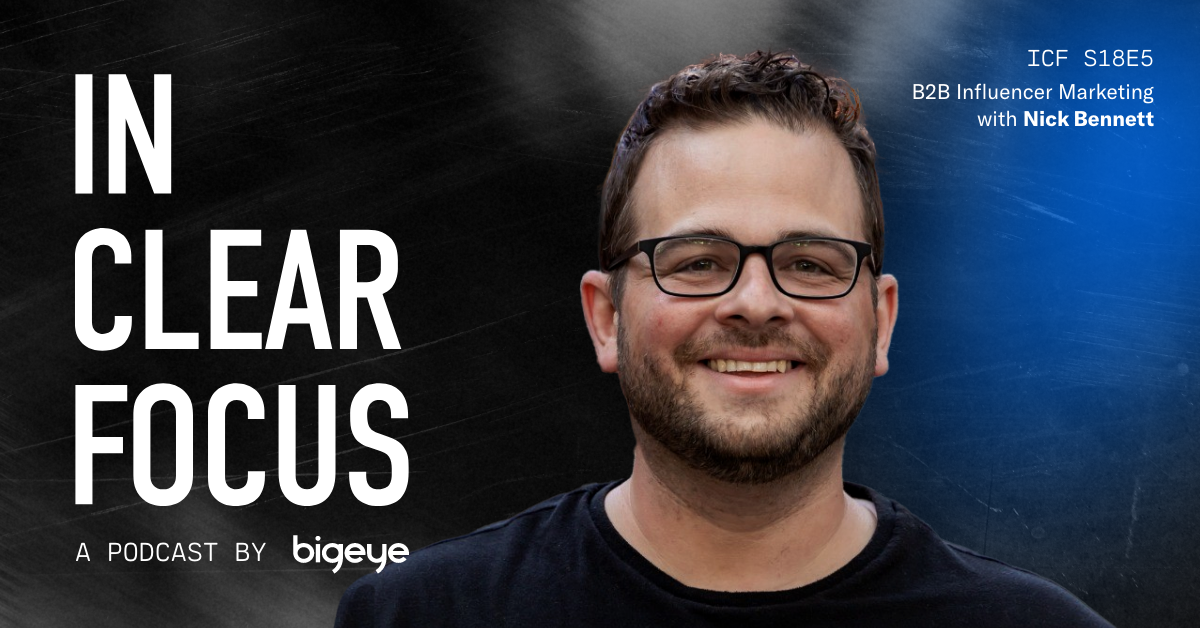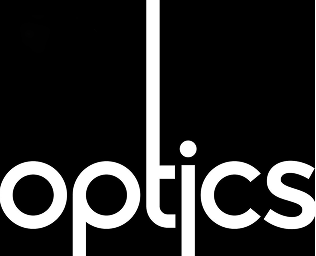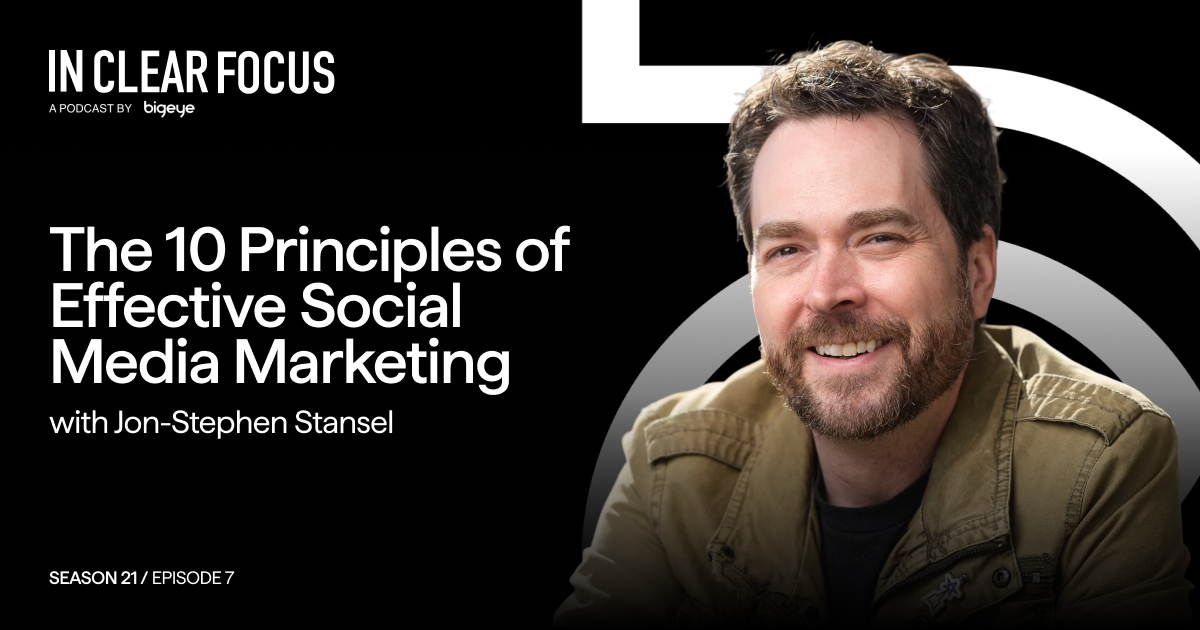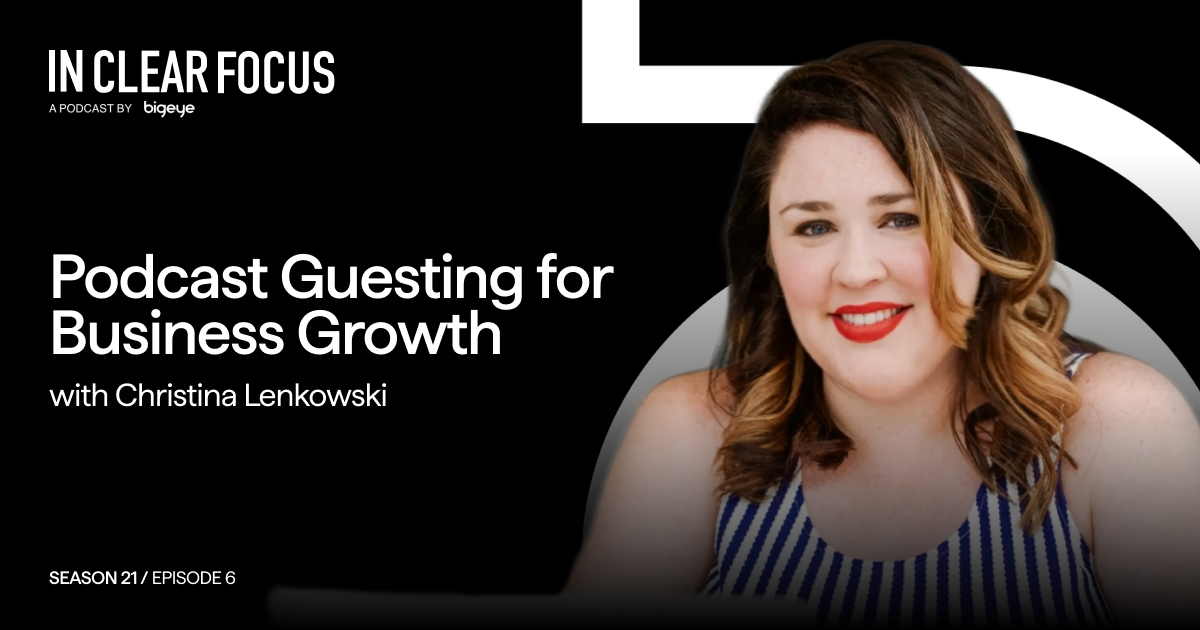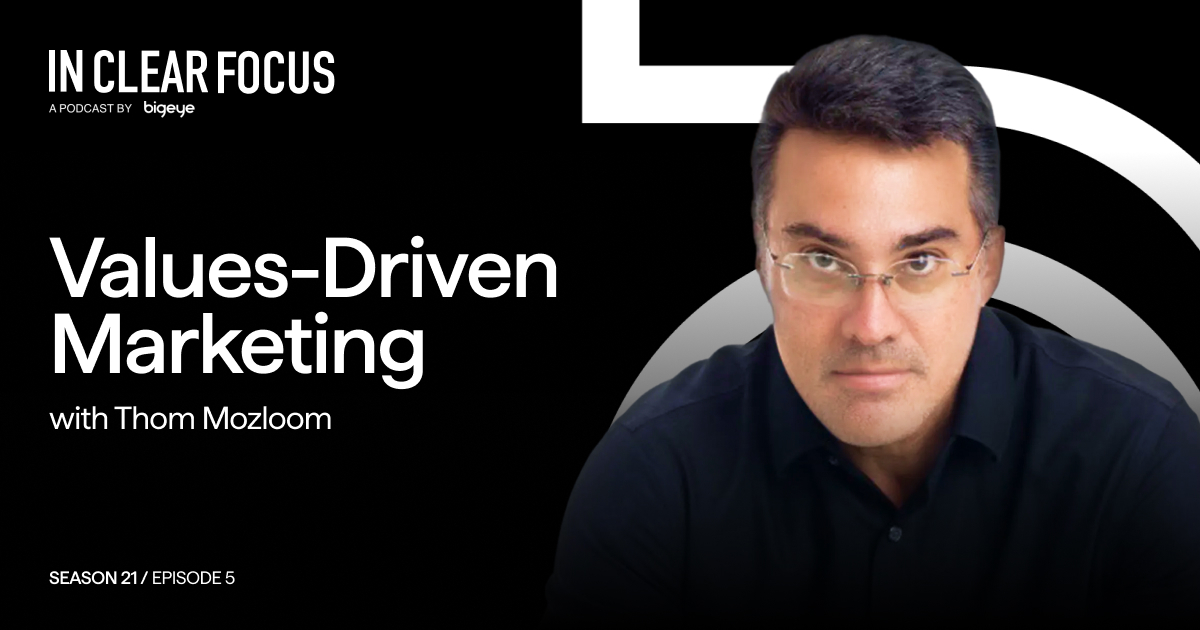IN CLEAR FOCUS: Nick Bennett, co-founder of TACK and author of “B2B Influencer Marketing,” discusses the evolution of creator partnerships in B2B marketing. Nick shares insights on building authentic relationships, measuring ROI, and leveraging LinkedIn effectively. He emphasizes the growing importance of micro-influencers, video content, and maintaining authenticity in an AI-driven landscape. Learn how B2B brands can develop successful influencer strategies and foster a creator-first mindset.
Episode Transcript
Adrian Tennant: Coming up in this episode of IN CLEAR FOCUS
Nick Bennett: Building long-term relationships with creators can significantly impact brand perception, audience engagement, and overall business growth. The issue is there’s not really a playbook in B2B, which is the whole reason why I wanted to do this. I want to lead from the forefront and hopefully set more brands up for success down the road.
Adrian Tennant: You’re listening to IN CLEAR FOCUS, fresh perspectives on marketing and advertising produced weekly by Bigeye, a strategy-led full-service creative agency growing brands for clients globally. Hello, I’m your host, Adrian Tennant, Chief Strategy Officer. Thank you for joining us. While consumer brands have long leveraged influencer partnerships, B2B companies are now discovering the power of authentic voices to build trust and drive growth. As the lines between personal and professional content blur on platforms like LinkedIn, understanding how to collaborate with creators and thought leaders effectively has become crucial for B2B marketers. Our guest today is an expert in helping businesses navigate this landscape. Nick Bennett is the co-founder and chief customer officer of TACK, a media and go-to-market firm. With over a decade of experience in B2B marketing, Nick specializes in go-to-market strategies and champions a people-first approach to drive revenue growth. He’s also an active content creator himself, maintaining a strong presence across platforms including LinkedIn, X, TikTok, and YouTube. And he hosts multiple podcasts, including The GTM Newsdesk. Nick’s new book, published by Kogan Page, is “B2B Influencer Marketing: Work with Creators to Generate Authentic and Effective Marketing,” which is our selection for the Big Eye Book Club this month. To discuss some of his book’s key ideas, I’m delighted that Nick is joining us today from Boston. Nick, welcome to In Clear Focus. Thank you for having me. Let’s start with TACK, Can you tell us about the company and how your work there intersects with B2B influencer marketing?
Nick Bennett: Yeah, absolutely. So TACK is a media and go-to-market firm focused on helping businesses convert demand into revenue using a people-first approach. Now, it integrates B2B influencer marketing by building authentic, creative first strategies that align brands with influencers to foster meaningful engagement and drive measurable results.
Adrian Tennant: Well, your book provides a comprehensive look at B2B influencer marketing. Nick, what inspired you to write it? And who did you have in mind as your target audience?
Nick Bennett: Yes, I’ll be honest. I actually had no intention to ever write this book. But when Kogan Page came to me, it was such a fun thing that I wanted to kind of, you know, check that off the bucket list. And here we are. But the inspiration came from a belief in the power of influencer marketing to transform B2B strategies. So the target audience, I would say really any B2B marketer, business leaders, and organizations looking to integrate influencer marketing into their go-to-market plans. And the book provides practical frameworks and insights for both beginners and those seeking to enhance their existing programs as well.
Adrian Tennant: In the book, you discuss the evolution of influencer marketing. How has B2B influencer marketing developed differently from B2C, and what unique challenges does it face?
Nick Bennett: I think some of the things is, when you think about B2B, it’s really a lot of times longer sales cycles, more complex buying processes, and the building trust with the decision-making committees. There’s so many buying committees in B2B, especially as you get into those larger enterprise systems. Whereas unlike B2C, which I feel like emphasizes consumer engagement and quick transactions, B2B is going to require that deep thought leadership, industry credibility, And some of the challenges when I think about those, it’s identifying niche influencers, navigating different platforms like LinkedIn or TikTok, improving ROI in complex sales environments.
Adrian Tennant: You also introduced the concept of Influencer Marketing 2.0. Nick, can you explain what this means and how it emphasizes the shift toward creators as collaborators?
Nick Bennett: Yeah, absolutely. So it represents a shift from transactional relationships to collaborative partnerships. And so it views creators as integral partners to align with brand values and help develop authentic content. It fosters deeper connections with the audiences through co-created and tailored strategies. It’s not as transactional as things used to be. And a lot of people ask me, like, what was the way things used to be? It was, hey, go buy this product. And it was so black and white, but there’s ways to go way beyond that. And I think a second piece of that is you have influencers within your organization in a lot of cases. How did these organizations empower these creators and get them to create content? Because ultimately, it’s a win-win. And that will be the other evolution of what’s coming and what you’ll see more of this year.
Adrian Tennant: One of the practical aspects you cover in the book is how to craft successful B2B influencer campaigns. What are some key steps for businesses just getting started with influencer marketing?
Nick Bennett: Yeah, I think there’s really five. So I think the first thing is you have to define clear goals and objectives. And if you don’t start with this, you’re going to be in a lot of trouble because I’ve had people that have skipped this first step and tried to go right beyond it and then come back to it. It never works. Trust me, I have seen this dozens and dozens of times, never works. And I wouldn’t even say just for influence of marketing, just in general, always set clear goals and objectives. Second thing is identify influencers who align with your brand values and audiences. You could have someone that could have the biggest amount of followers, but they don’t align with your values. Very important to find people who do. Third thing is build authentic collaborative relationships with those creators. Show them that you actually care. Show them you consume their content. Show them that you want to have them part of that team. Fourth thing, leverage platforms like LinkedIn, YouTube, all of those things. There’s so many platforms and more and more, I’m sure, are going to continue to pop up. Leverage those platforms. And the fifth thing is focus on measuring ROI using metrics like engagement rates, pipeline impact, actual revenue impact on top of it, which goes back to that first thing is, why am I doing this? What are those goals and objectives that I have out of this program?
Adrian Tennant: Well, you just gave us some great ideas for getting started with influencer marketing. A question we get a lot is, where do you find business-to-business influencers?
Nick Bennett: A lot of times, you’re already consuming their content. It’s most likely on LinkedIn. That’s where I would say the majority of them are. But as we’re scrolling LinkedIn, there’s probably people that you read every single day, and you’re just like, hey, I like this person’s insights. They’re a well-known person who talks about, let’s just say, account-based marketing, always talk about account-based marketing. And they seem to have a very engaged community and audience that also cares about that. And so you’re probably already following these people. It’s just showing up and making sure that you’re commenting on their stuff, that you are feeling like you’re a part of this. And I’m seeing this a little bit, but you’re seeing marketplaces pop up. B2C has this, but B2B does not have influencer marketing marketplaces, or at least there’s not a ton. They’re starting to pop up more recently. And you’re going to be able to go on and find people that align with like, hey, I need to talk about AI and marketing. And you’re going to be able to go and find these 10 people that talk about this from a curated kind of database perspective. And I think that will be a big game changer on how to actually find people.
Adrian Tennant: You mentioned platforms are starting to appear online. Do you have experience using any of them?
Nick Bennett: Yeah, so I actually, I advise a company called Limelight and they’re building one of these. And I’ve actually done a few campaigns myself where they’ve signed up brands and I’ve partnered through there. It’s actually pretty fantastic. They handle all of the contracting. It’s super simple, one platform. And I actually have like a store on their website so people can stop by, see what I charge for rates, all of those things. And then we do the negotiation over messages. It’s all in one platform. And then it actually has a Chrome extension that connects to LinkedIn and will pull my data from one specific post once I click approve. And it will go back to that brand so that they can have all of their inputs to see if the campaign was successful or not.
Adrian Tennant: Thank you for the recommendation. For our listeners who work primarily in business-to-consumer marketing, but whose brands also have B2B divisions, how can they adapt B2B influencer marketing principles to serve both audiences?
Nick Bennett: Yeah, it’s a good question. I think ultimately it’s bridging the gap by focusing on trust-building and authentic content. That’s going to be key regardless if it’s B2C, B2B, different vertical segments. It doesn’t really matter. Those two things you’re always going to come back to. For the B2B divisions, I think one of the things is, again, it’s going on LinkedIn. It’s targeting these people that have domain expertise. It’s using storytelling to highlight the solutions for business challenges. So often, when I see a creator or influencer post something, I don’t want to see them just out there promoting a product and it’s just like, hey, here’s the features. It doesn’t do anything for me. But when you use storytelling to basically come across and say, hey, this is how I’m using it, or this would be a fantastic way for a marketer to use it. Here’s some use cases. Maybe it’s a video, maybe it’s a tutorial that I could learn from. Those are the types of things that I personally enjoy a lot more.
Adrian Tennant: In the book, you discuss various social platforms. Nick, which ones do you see as most effective for B2B influencer marketing and why?
Nick Bennett: Yeah, LinkedIn for sure, just because of everything from its audience. When I started in March of 2020, posting on LinkedIn, and at the time it was 650 million users, and 1% of people created content. Now, 2025, I believe that they just crossed over a billion users. And I think that number went from 1% to 4% that is creating content. Now, it’s still a very, very small number when you think about it. but everyone is on LinkedIn unless, you know, obviously there’s some industries that aren’t, but I would say LinkedIn without a doubt. Now you could look at, you know, X for example, it’s okay. It’s not a channel that I’m actively using. And then YouTube, I would say for in-depth thought leadership, long-form content in the shorts piece, I use YouTube and it’s something that I’m doubling down on, in 2025. We have about 36,000 subscribers on our YouTube channel right now. And my goal is to get that to over 100,000 by the end of 2025. So a couple of good big things. Obviously, you got TikTok, which might not be here. Instagram, you got Blue Sky. Honestly, I’m waiting for someone to build the next LinkedIn. Because I feel like LinkedIn is becoming a lot more pay to play. And it’s tough because the thought leadership ads, I feel like, have made it where they’re throttling people’s content that aren’t paying to get sales nav or all of these other things. I just want another platform to go back to what LinkedIn used to be 10 years ago.
Adrian Tennant: You talk about the importance of measuring ROI from influencer marketing. What metrics should B2B marketers focus on?
Nick Bennett: I think it goes back to your key objectives and what are the goals from the campaign. But you could look at things, you know, engagement rates. You know, if you’re doing a LinkedIn campaign, for example, to do some type of brand awareness play, you’re trying to have a lightning strike day. Think of it as like, likes, shares, comments, things like that. You could have leads generated through different campaigns. Personally, I don’t like this one as much because it’s tough. It’s very much a B2C play when I think about that one. The piece that I do like and I feel like is very underutilized in the B2B side, especially with influencer marketing, is conversion rates within the sales funnel that influence, basically. I think it’s something that’s hugely undertapped and that more people should take a look at. I feel like I should write some more content about that because, again, people just don’t know what are those benchmarks, what should it be. Fourth one would be pipeline impact, revenue attribution. I think that’s something that a lot of companies, brands, especially with budgets as tight as they are, are starting to look at. And then, you know, brand sentiment analysis from social listening tools that are out there. If you’re partnering with these brands, is their sentiment analysis going up? Is their brand, like, are people happy with their brand? I think those are all things that you could look at.
Adrian Tennant: Let’s take a short break. We’ll be right back after this message.
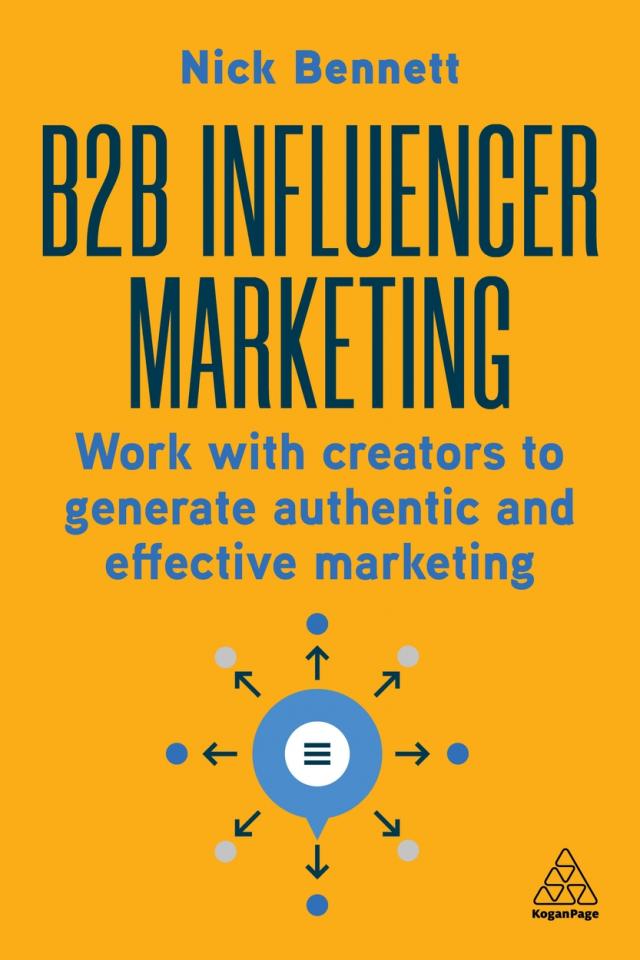 |
Nick Bennett: Hi. I’m Nick Benett, author of “B2B Influencer Marketing: Work with Creators to Generate Authentic and Effective Marketing.” My book provides a practical guide for business-to-business brands looking to partner with creators who align with their brand values and can help deliver real business results. I break down key concepts and explain how to develop effective Influencer marketing strategies, from identifying the right partners to measuring campaign success. Whether you’re new to B2B influencer marketing or looking to enhance your existing programs, this book offers actionable insights and frameworks to help you succeed. I hope my book helps you transform your B2B marketing strategy with the power of authentic creator partnerships. Thank you! |
Adrian Tennant: Welcome back. I’m talking with Nick Bennett, co-founder and chief customer officer of Tack, and the author of B2B Influencer Marketing, this month’s Big Eye Book Club selection. Nick, let’s talk about the writing process. Now, this is your first book, and I understand you wrote it while raising three young children, including twins. How did you manage to balance it all?
Nick Bennett: Yeah, it required discipline, time management, early mornings, late nights were key. Because to be honest, from when I end work to around, you know, seven o’clock at night, I try not to be on my phone, it’s very much like all about the family time. Once everyone is in bed, that’s when I started to do a lot of my work. And like, if I could chunk like, oh, I would say two to three hours a night, I was always in early riser, so waking up at 5 a.m. wasn’t really anything different for me. It was just getting up instead of just laying in bed, scrolling on my phone for a little bit. It was jumping up and like, all right, cool, I want to write a chapter. I want to write a little bit of this chapter or something like that. It did take me a year and a half to get this done. There was weeks where, you know, I couldn’t put as much time in it. And then there was weeks where I could put more time. So it definitely required balancing that family life as well as that discipline time management.
Adrian Tennant: Looking ahead, what trends do you see emerging in B2B influencer marketing?
Nick Bennett: I think what we’re going to see is an increased reliance on micro and nano influencers for niche engagement. So many people think that you need to go get someone with 100,000 followers. Far from the truth. If you can find someone that talks about a very specific pain point to your audience that has 15, 20,000 followers on LinkedIn, I would take that all day long because those people have such an engaged community of people that believe in them, that support them, versus the people that have these big audiences, half the time they can’t even reply to the comments that they’re getting. So I think that’s one. I think the other piece is greater use of data and analytics to tailor your campaigns. Again, there’s going to be platforms that continue to pop out. There’s going to be new tools that come out to continue to focus on the analytics. How do I integrate influencers into the rest of my marketing strategy. I think that’s huge for sure. I think the integration of video content across platforms, I’m sure you’ve seen it yourself. LinkedIn is definitely focusing more on video. They have their own video tab now. It’s very much reminds me of like an Instagram-ish type thing. And I think you’re going to see a lot more integration of video across multiple platforms. And obviously, you know, YouTube being a big piece of that. And the last thing that I would say is expanding influence through long-form and educational content. So many times people think it’s like the short-form content that wins, but writing this long-form content and utilizing the SEO side of it is huge if brands can figure out how to leverage it properly.
Adrian Tennant: As regular listeners know, we love case studies on IN CLEAR FOCUS. So Nick, can you share a success story of a B2B brand effectively using influencer marketing?
Nick Bennett: Yeah, absolutely. So we actually partnered with a company months ago, but they were launching a new AI product. They feel like everyone’s releasing AI products. And they’re like, listen, we need to have a lightning strike type of day. We need to take over LinkedIn. We want everyone to know what we’re releasing more from a usage standpoint, from a marketer perspective. And so we found 15 people that used the product for a little bit, could talk about it, could make videos on it. And on a specific day, we all posted about it. And they saw it was about a 200% increase to their website traffic. And out of that, I forget the exact number, that was a close one. It was a very easy sale where, you know, hey, you get on the website, it was pretty much like a one-call close. And they closed a ton of deals from that one post. Now, the thing that they could have done and expanded on this is making it more than just a one-off campaign. They wanted it from a product launch perspective. Now, if they just integrated that into their quarterly calendar, they probably would have had so much more success. But hey, I mean, a little success is better than no success.
Adrian Tennant: Excellent. What role does authenticity play in B2B influencer partnerships?
Nick Bennett: Yeah, you got to stay true to yourself. AI has made it where it’s so easy to see through who’s using AI and who’s not. And the people that are authentic, that are genuine, that can come out and use storytelling to basically get their message across, those are the people that are going to win. And I feel like the people that have been doing it for years are the ones that you know, you can trust, you’ve seen it, you’ve been on their journey for years. Just AI has made it so easy where everyone is popping up and everyone has become a creator because AI has made it so easy to do so, but they don’t hold any credibility in what they’re talking about, at least not yet because it’s early and a lot of people are looking for the shortcuts to be able to get to that next point, but they’re not realizing that, hey, it’s taken me five years to get to this point.
Adrian Tennant: Nick, have you got one particularly egregious example of the use of AI that you’ve seen recently?
Nick Bennett: Yeah, I would say there is this one brand, I won’t mention any names, but they went through and they partnered with a bunch of creators. And the only reason I know is because they reached out to me and they wanted AI to write the post and they wouldn’t let you change the content that was in there because it was an AI product. I get that piece of it, but to not have any human touch point in it. And I tried it out. I tried the product just because I wanted to see, hey, are these results actually amazing? And they weren’t. It’s still read very robotically and it was supposed to pick up on all of your previous LinkedIn content to basically come across as you. And there was still things I would have changed. And I was just like, listen, if I can’t change any of this content, there’s no way I’m hitting publish on this.
Adrian Tennant: Yeah, that does seem like a major omission for a product. So, Nick, how can marketing leaders foster a creator-first mindset within their teams?
Nick Bennett: It’s a good question. I think it needs to start from the top. So often what you see is founder-led sales, founder-led marketing. There’s so many founders that are posting on LinkedIn that believe in the value of creating content. And those are the people in the brands that are going to win this creator-first mindset because they know how valuable it is. Sometimes they don’t have as much time, which is why they hire ghostwriters and a bunch of other things, but they know it is a place they need to show up because their customers are there, their prospects are there, their VCs are there, everyone is there. But if you can start from the top and get them to empower everyone else in the organization by leading by example, and again, in B2B specifically, you see so many founders that are creating content on LinkedIn and they’re like, wow, this actually works. I’m booking meetings, people are referencing it when we have sales calls, all you have to do is lead by example. And then if you can create a few others and think about it as like employee advocacy, the next generation of it, because employee advocacy used to be like, Hey, go post this. It’s another company post, blah, blah, blah. This is the next wave of that, where it’s like, hey, our CEOs posting, our head of finance posting, whoever it is, you see them posting, they’re having success, you want to build your personal brand, and some people don’t like that term personal brand, but listen, everyone has one. I haven’t used a resume to apply to a job in like seven years. Every job that I’ve gotten has been because of the audience in what I put on LinkedIn. They can see how my mind works. They can see how I think, how I solve problems. And if you can get your employees to do that and start to build an army of people, Think about, one, how many impressions you’ll drive, and your media value is just going to skyrocket if you can make this successful. And I’m not saying that you need 100 people to start jumping and do this, but start with a small group, 10 people, move that to 30, 50, all of a sudden you do have 100 people doing it.
Adrian Tennant: Well, we’ve talked about a few examples, but I’m curious, how do you foresee AI impacting B2B influencer marketing over the next year or two?
Nick Bennett: Yeah, it’s interesting because I feel like it’s going to make it where people are going to try to use this as a cash grab. And they’re going to want to be like, yeah yeah, I can talk about whatever. There’s a few influencers out there that don’t write their own content. And the reason that I know this is because I have tried to pick their brain. And when you get into a one-on-one conversation with them, they can’t back up or talk about what it is that they typically talk about because they don’t know it. They know surface-level stuff, but they don’t know it from a deeper level because they’ve never been an actual practitioner. They’ve used AI, and I think AI has helped a lot of people from like a surface-level standpoint where I can stay relevant, I can talk about a little things, but I can’t talk about being in the trenches. And I think the difference is you’re going to see who can do the work and who can only talk about the work. And AI is going to make that pretty blatant.
Adrian Tennant: What’s the one thing you’d like readers to take away from your book?
Nick Bennett: I would say the importance of trust and authenticity, building long-term relationships with creators can significantly impact brand perception, audience engagement, and overall business growth. The issue is there’s not really a playbook in B2B, which is the whole reason why I wanted to do this. I want to lead from the forefront and hopefully set more brands up for success down the road.
Adrian Tennant: Great conversation. Nick, if listeners would like to learn more about your work at TACK or connect with you online, what’s the best way to do so?
Nick Bennett: Yeah, absolutely. I would say LinkedIn is definitely the best place. Start there. I have a link tree on my LinkedIn that breaks out everything else if you want to check all my other social links and websites and all that stuff as well.
Adrian Tennant: And a reminder that you can save 25% when you order a copy of “B2B Influencer Marketing” directly from the publisher at koganpage.com. Just enter the promo code BIGEYE25 at checkout. Nick, thank you very much for being our guest this week on IN CLEAR FOCUS.
Nick Bennett: Thank you for having me.
Adrian Tennant: Thanks again to my guest this week, Nick Bennett, the author of this month’s featured book, “B2B Influencer Marketing.” As always, you’ll find a complete transcript of our conversation with timestamps and links to the resources we discussed on the IN CLEAR FOCUS page at Bigeyeagency.com. Just select Insights from the menu. Thank you for listening to IN CLEAR FOCUS, produced by Big Eye. I’ve been your host, Adrian Tennant. Until next week, goodbye.
TIMESTAMPS
00:00: Introduction to “B2B Influencer Marketing”
00:34: The Power of Authentic Voices in B2B
01:17: Meet Nick Bennett: Expert in B2B Marketing
02:00: Inspiration Behind the Book
02:37: B2B vs. B2C Influencer Marketing
03:24: Understanding Influencer Marketing 2.0
05:21: Key Steps for Successful B2B Influencer Campaigns
06:54: Finding B2B Influencers
08:01: Using Influencer Marketing Platforms
09:00: Adapting B2B Principles for B2C Marketers
10:05: Effective Platforms for B2B Influencer Marketing
11:44: Measuring ROI in Influencer Marketing
13:00: Break and Book Promotion
14:10: Balancing Writing with Family Life
15:28: Emerging Trends in B2B Influencer Marketing
17:05: Case Study: Successful B2B Campaign
18:30: The Role of Authenticity in Partnerships
19:27: AI’s Impact on Influencer Marketing
20:28: Fostering a Creator-First Mindset
22:40: Future of AI in B2B Influencer Marketing
23:39: Key Takeaway from the Book
24:11: Connecting with Nick Bennett
24:54: Closing Remarks and Resources
